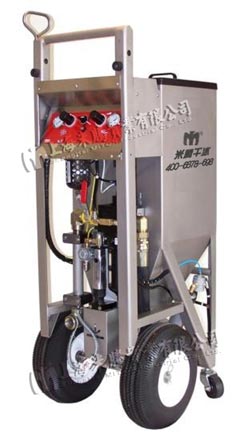Cleaning with dry ice! This new development is quickly expanding around the world. One system uses small rice size pellets of dry ice shooting them out of a jet nozzle with compressed air. It works somewhat like sandblasting or high-pressure water or steam blasting, with superior results. The frigid temperature of the dry ice -109.3°F or -78.5°C "blasting" against the material to be removed, causes it to shrink and loose adhesion from its sub surface. Additionally when some of of dry ice penetrates through the material to be removed, it comes in contact with the underlying surface. The warmer sub surface causes the dry ice to convert back into carbon dioxide gas. The gas has 800 times greater volume and expands behind the material speeding up its removal. Paint, oil, grease, asphalt, tar, decals, soot, dirt, ink, resins, and adhesives are some of the materials removed by this procedure. Only the removed material must be disposed of, as the dry ice sublimes into the atmosphere.

Replaces Sandblasting:
This method is superior to sandblasting because the dry ice is soft enough not to pit or damage the underlying surface. The dry ice sublimes quickly into the air and only the removed material must be cleaned up. Dry Ice blasting eliminates equipment damage in two ways. First, dry ice does not erode or wear away the targeted surface as traditional grit media and even wire brushes do. This means that surface integrity and critical tolerances are preserved and equipment will not have to be replaced due to surface erosion common with sand, glass beads, and other abrasive media. Second, with traditional cleaning methods, equipment is often damaged (bumped, dropped, etc.) while in transit to or from the dedicated cleaning area. Instead most equipment and machinery can be cleaned while in place.
Dry ice blasting is also an improvement over steam and water blasting for several reasons:
1) Electrical parts and generators can be immediately put back into service used without waiting to dry.
2) Radioactive contaminate removal doesn't require large storage containers for contaminated water.
3) Mildew and mold removal are far more complete with less chance of regeneration because of water vapor or moisture.
4) Dry ice blasting removes more algae, sea slime, and mussels on boat hulls, than water blasting, which allows the organic matter to reattach sooner.
Replaces Environmentally Damaging Solvents
Finally Dry Ice blasting is used in place of many environmentally damaging solvents. These chemicals include trichlorethane, methylene chloride, perchlorethane, orthodichlorobenzene, cresylic acid, and caustic solutions. Since dry ice evaporates completely as a gas it leaves no wastes. Only the material being removed must be disposed of. When dry ice cleaning replaces hazardous chemical cleaners the disposal cost of that chemical is eliminated. Tinker Air Force Base has reported it eliminated hazardous waste disposal associated with 17,000 gallons of chemicals they no longer need to use each year because of dry ice cleaning.
Drawbacks
(1) The loud noise produced requires protective earphones and may cause irritation to other people nearby although newer machines are much quieter.
(2) Effective cleaning can only occur in a straight line of sight from the Dry Ice jet nozzle. Sometimes parts can be dissembled to help.
(3) Large amounts of carbon dioxide are released which can be harmful if not ventilated out of the space.
Adhesives
Adhesives are easily removed in comparison to alternative methods as the lowered temperature serves to weaken the adhesive bond. Many companies are blast cleaning old labels off containers that are being re-used. Abrasive methods often generate heat and can therefore fail with some adhesive removal.
Fire remediation
Dry Ice cleaning is extremely effective in removing toxic residues, soot, and associated smells after a fire. Independent dry ice blasters often work with major insurance companies over a large geographic area to quickly clean fire and smoke damaged locations.
Food and Hospital Use
Dry Ice cleaning of the surface of products and instruments is not toxic and will stop the growth of mold, mildew and other fungi as well as stopping odors at the source by elimination of the bacterial host environment, not as a masking agent or cover-up. Dry Ice cleaning is 100% ecologically safe, USDA rated, biodegradable and harmless to humans, animals and marine life.
Additional Places Dry Ice Cleaning Has Been Used
| Electrical |
Commercial |
Electronic/electrical control panels
Cable trays Motors/Stators
Armatures/Coils/Windings
Generators
Printed Circuit Boards
Semi-Conductors
Transformers
Switch Gear
Robotic Equipment
Relays
Turbines
Insulators
Sub-Stations |
Buildings
Exterior/Interior
Hospitals Nursing Homes
Hotels
Residential
Structures
Heating/Cooling Systems
Bricks Wood
Remediation/Restoration
Graffiti Decal Removal |
| Food |
Industrial |
Ovens
Floors
Walls
Processing Equipment
Equipment Ceilings
Conveyors
Bake-Off trays
Packaging Areas and Equipment
Other
Cigarette/Cigar Smoke
Formaldehyde
Beauty Salons
Waste Containers
Nuclear Decontamination
Fire Restoration
|